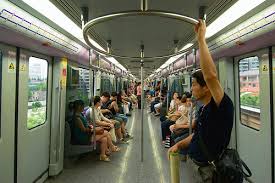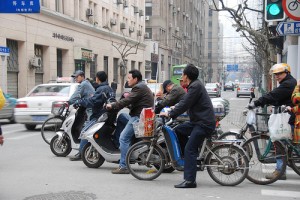
For my junior and senior years of high school, I moved to Wales to attend boarding school. I have always been fascinated by metro systems so I developed a quick familiarity with the London Underground during frequent weekend and school holiday visits. I would spend hours exploring the city on the Tube, sometimes just popping up at a station to check out its interior before descending into the subterranean depths again. I have since had brief affairs with the Boston T, the New York City Subway and the DC Metro, but none of them quite compare to the Tube.
In the last month, however, I have been navigating a new metro system in a new language, which also happens to be the largest (by area covered) in the world. I am currently a Research Intern with the Partnership on Sustainable, Low Carbon Transport (SLoCaT) in Shanghai. SLoCaT functions as a convener, bringing together civil society organizations, national governments, private companies, academic institutions, multilateral development agencies and other stakeholders in the transport sector. Its goal is to promote the integration of sustainable transport into global policies on sustainable development and climate change.
Our work at SLoCaT is especially relevant because transport sector emissions are the fastest growing category of greenhouse gas (GHG) emissions, representing about 25% of global emissions, with aviation and road transport serving as key drivers of this growth. Although these trends may seem dismal, the sector has huge potential for emissions reduction through sustainable mobility strategies. In fact, new research suggests that expanding access to public, non-motorized and low-emission transport can save cities more than $600 billion by 2030. This level of investment can also yield up to 2.8Gt CO2 equivalent in annual GHG abatement by 2050.
From Shanghai to Paris

When I entered the office on my first day, my eyes were drawn to a model of the Eiffel Tower and a pile of scarves adjacent to my desk. I didn’t think too much of either until my supervisor informed me that I would be joining the team in Paris at the UN Climate Change Conference this December (COP21). Consequently, I have been working on developing the Paris Process on Mobility and Climate (PPMC), a unique platform hosted by SLoCaT to triangulate global sustainable transport policies and incorporate them into the upcoming climate negotiations. Apart from the sessions to develop the negotiating text for COP21, there are also several national and regional dialogues taking place to formulate common advocacy messages and knowledge products.
Because SLoCaT will have a booth at COP21, we are organizing several side events in collaboration with partners like the International Union of Railways and Michelin Challenge Bibendum. Not to be outdone by other civil society organizations, SLoCaT has often engaged in guerilla marketing to spread its message at the annual COPs. In Paris, our scarves will make sure that delegates are nice and warm (and thinking of sustainable transport) while debating the finer points of negotiating text.
Global focus, local relevance
Since I moved to China, I am more aware of my place (and time) in the world than ever. Nothing crystallizes the distance between New York and Shanghai like the 12-hour time difference. Although my work day typically ends around 6pm, it is not unusual for one or more of us to stay late, fielding calls from the Netherlands, Chicago or Paris. SLoCaT is often buzzing with conference calls as we update our partners on our recent work and track countries’ Intended Nationally Determined Contributions (INDCs) for emission reduction plans within their domestic transport sectors.

Even though SLoCaT operates with a global scope, some of the most important policymaking in the transport sector happens at the national or regional level, and such efforts can have significant impact on reducing emissions. This is the case in Shanghai, the largest metropolis in China, where recent policies attempt to mitigate the smog generated by car exhausts and local industry. Here, the air quality index holds definitively more gravity than the weather forecast. To tackle this issue, the government banned fossil fuel-powered motorbikes. In addition, vehicle license plates are prohibitively expensive. It is highly encouraging to see so many electric bikes and scooters (and also a little disconcerting because they use the sidewalks), demonstrating how incentives can be designed to foster more sustainable travel behavior.
Connecting to coursework
Reflecting about incentive structures for sustainable transport brings me back to literature review I wrote in my first year at Bard CEP. In that assignment I analyzed several case studies to determine the factors that influence the adoption of congestion pricing schemes in urban areas. While there is no silver bullet to solving urban congestion and its associated emissions, it is important to communicate which strategies work and in what context. Sharing knowledge about sustainable mobility strategies enables policymakers to improve and speed up the deployment of these climate change actions.
To illustrate, bus rapid transit (BRT) has become a keystone of public transport infrastructure in many developing country cities. This has happened because municipalities shared best practices and learned from early adopters like Curitiba, Porto Alegre and Sao Paulo. The success of BRT also highlights the importance of international policy coordination to achieve global goals on sustainable development and emissions reductions in the transport sector. I hope to build on this research for my capstone thesis.
Ultimately, the implementation of sustainable transport policies will impact billions of people, from the largest megacities to isolated rural households, enhancing their ability to participate in the economy and expanding access to social and cultural amenities while mitigating global warming and improving climate resilience. I am excited to have joined the sustainable transport policy sphere at this moment and I hope to make a career in this field after my degree.

Its so nice to know that a fellow colleague is also working on iNDCs as well. You would be pleased to know that I have visited SLoCaT’s website to obtain quick information from their iNDC transport sector summaries when assessing those and other sectoral mitigation potentials per country. Great work!
Thanks Jen & Keston. Will make sure to keep posted on Paris and my thesis.
Here’s another recently submitted INDC by Grenada : http://www4.unfccc.int/submissions/INDC/Published%20Documents/Grenada/1/Grenada%20INDC.pdf. Look out for the summary on our website soon.
Perfect. I keep my eyes open for it.